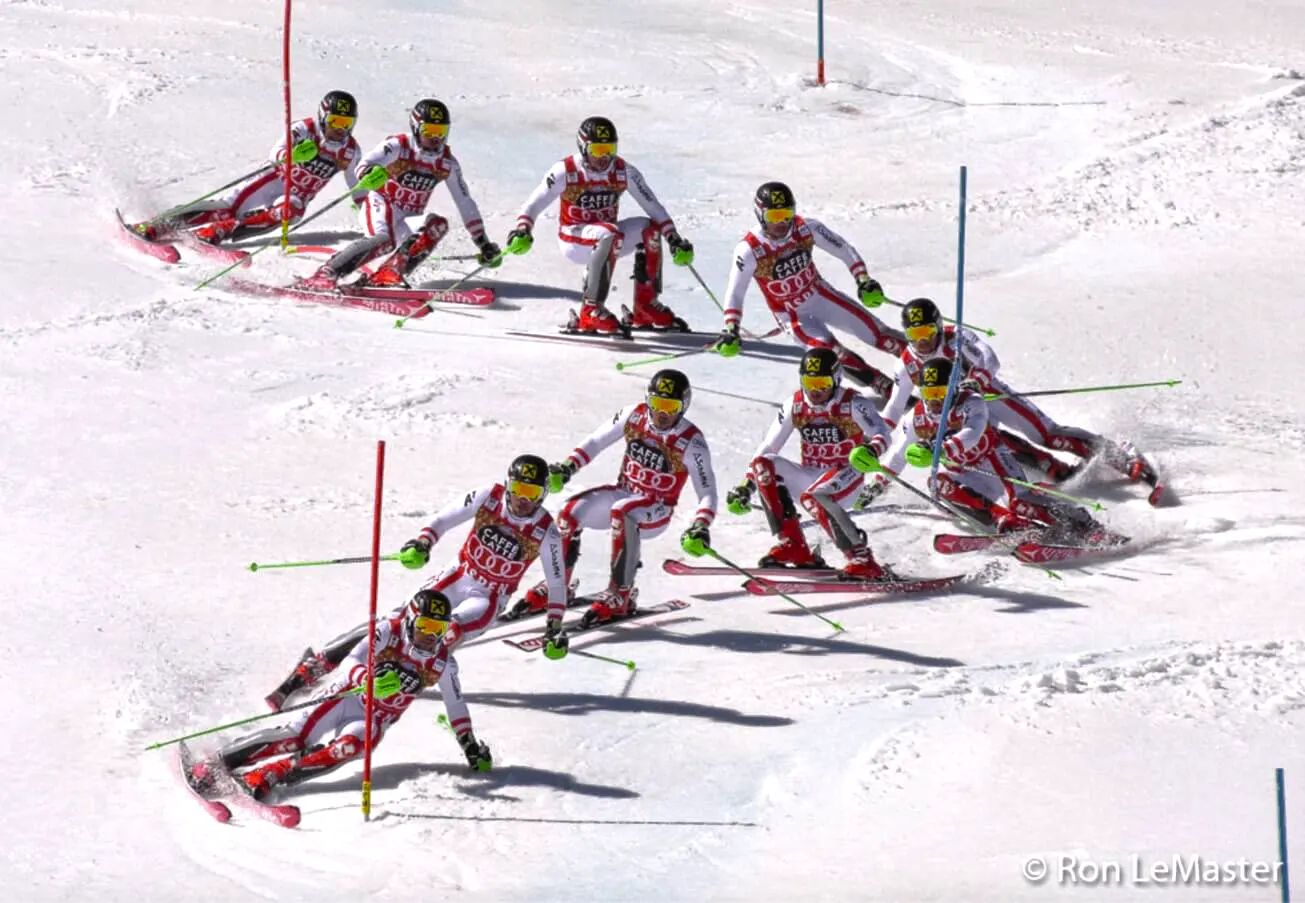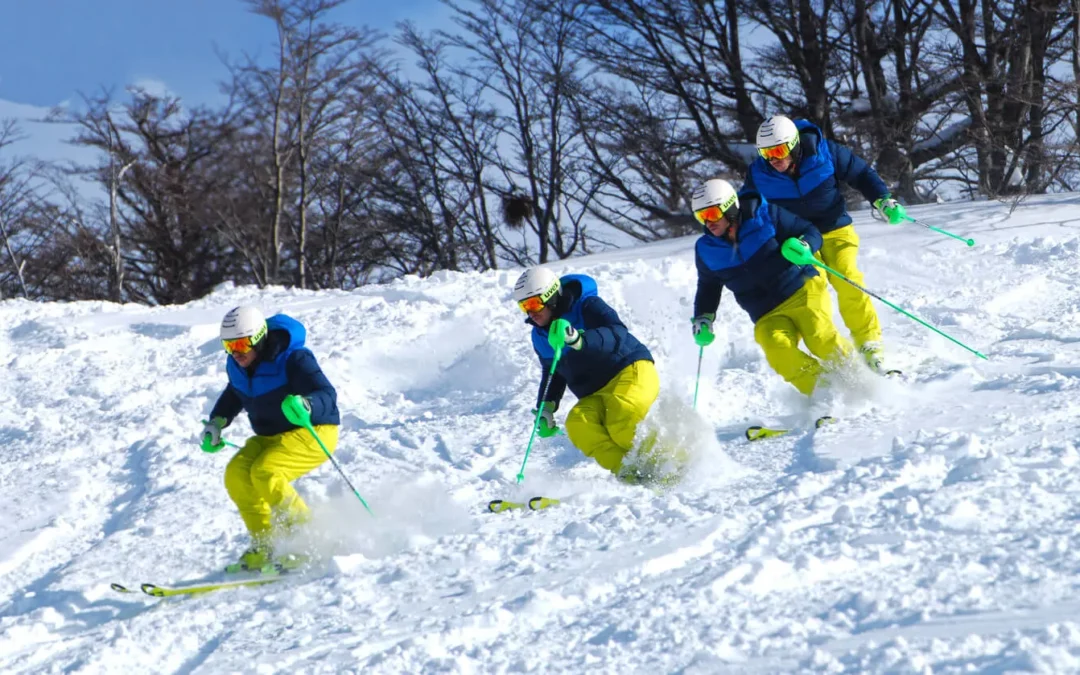In skiing fore-aft balance is dynamic, not static. It is in a constant cycle. In regular high-level skiing, skiers always go from being back at the end of one turn to being forward at the initiation of the next turn. Pressure translates from tip to tail throughout the turn.
As Mikaela Shiffrin in an interview (here) said: “The key for fore-aft balance, for me, is to try not to stay in one position. Because skiing is such a fluid sport, you’re always moving. And if you become static with your fore-aft balance, then the rest of your turn is going to be static. So, it’s really important to be able to be forward at the top of the turn and then try to use the rear of the skis. Not the tails really, but you know let your skis kind of shoot out from under you a little bit. Just try to play with the entire ski because you have a whole ski for a reason. You want to use the whole thing as a tool. And if you can use the tip-to-tail perfectly and be in balance, then you’re going to have a faster turn.”
In order to start a turn effectively, we need to move our Center of Mass forward to bend or balance over the front of the skis. We must start the turn by engaging the tip of the ski, so we always look for “getting to the front of the ski” at the initiation.
That’s key in order to:
- Get tip pressure to allow the ski tip to enter the snow and excavate a groove for the rest of the ski to follow (carve the turn). Getting the ski tip to engage at initiation is essential.
- Be centered (I.E. pressure the middle of the ski) when we arrive at the most important part of the turn: the loading phase. The loading phase is when we apply almost all the pressure and the major ski deflection occurs. In the modern slalom technique (SL turns), the pressure or loading phase is short and abrupt, and it happens all at once at the fall line (i.e. the middle or apex of the turn).
Also, the movement of the Center of Mass from the front of the ski to the tail is a movement that facilitates the ski arching. Utilizing the entire ski from tip to tail is crucial for high-level skiing.
The use of the tails at turn completion is unquestionable. So being back at transition is absolutely normal, and kind of looked for.
We use the whole ski (the whole length of the tool) in a high-performance turn. Being always forward is a mistake as bad as being always back. Fore-aft balance is dynamic, a constant cycle from front to back to front, and so on.
I honestly think several Ski Instructors Associations have to get better at this… Because I still hear on the slopes quite often: “you have to be always forward to have control”… One of the most world-spread misconceptions ever…
So again, it is absolutely OK (and actually looked for) to be in the backseat at transition, but it is mandatory to move our center of mass forward (or our base of support back) in order to be centered when we apply the majority of the load/pressure on the skis (at the fall-line).
“If everybody’s trying to whack super hard forward all the time and just hold that it’s physically impossible with the forces, and so you have to allow for the range of motion. It’s okay to get to the heel as long as you don’t stay there, and it’s the same thing if you’re always going to be hanging out in the front of the boot, that’s actually just as bad as being back. So range of motion is something that is really important and always something that you have to allow for because that’s how you create movement..”
Foot pressure translates from front to back throughout the turn advanced king
While the turn develops, the norm is that our CM moves backward and we end up finishing the turn with our balance over our heels and tails of the skis. At the feet level, the balance point moves from the ball of the foot at the beginning of the turn, back to the heels, at the end. That’s what happens naturally, even on short turns. In order to start a new turn again, we have to move our CM forward, and so on.
One study published in 2010 by T. Keränen et all., compared two groups of FIS-Ranked athletes, group 1 ranked higher than group 2. This study demonstrated that both groups had the same kind of center of plantar pressure fore/backward movement, which is associated with the ski’s bending during the turn. But the higher-ranked athletes were able to produce more force through the frontal part of the foot to the ski and their center of pressure trajectory had larger mediolateral movement than the lower-ranked group.
Thus, the better the skier, the more pressure on the ball of the foot is able to generate, and the more edge angle they produce as well.
“The key for fore-aft balance, for me, is to try not to stay in one position. Because skiing is such a fluid sport, you’re always moving. And if you become static with your fore-aft balance, the the rest of your turn is going to be static. So, it’s really important to be able to be forward at the top of the turn and then try to use the rear of the skis. Not the tails really, but you know let your skis kind of shoot out from under you a little bit. Just try to play with the entire ski because you have a whole ski for a reason. You want to use the whole thing as a tool. And if you can use the tip-to-tail perfectly and be in balance, then you’re going to have a faster turn.”
A great example and proof of this dynamic fore-aft balance while skiing is this state-of-the-art photo sequence made by Ron LeMaster that we will see and analyze below:

The athlete is Marcel Hirscher (A.K.A. the G.O.A.T.), performing some Slalom turns on the Aspen race course.
Here we can clearly see that he finishes his turns on the tails of the skis, as noted in the very next frame after the one hitting the blue gate/pole.
In the following frame, we can observe that the transition is definitely in the backseat and “floating”, with the skis almost in the air.
Then, he repositions forward and arrives at the last frame (the one where he is blocking the last red pole) centered and bending the ski completely from the waist. That is the apex of the turn. When the racer makes the majority of the direction change.
This invaluable photo sequence shows us that, as Mikaela says, to ski we must use the whole ski. Its entire length, from tip to tail. And that happens at each and every turn!
Also, this photo sequence of Marcel demonstrates that one of the best and most critical drills in skiing is the so-called Dolphin turns. It is a drill that exaggerates these fore-aft movements on every turn.
Called dolphin turns, as the movement of the skis is similar shape that a dolphin makes when jumping out of the water.
It is an advanced ski drill, in which you should hop off the tails of the skis and then shift forward as you land on the shovels and in the new edges. The trick is to push the feet forward and pop off your tails, and then pull your feet back with your heels up to land on the shovels. The edge change must occur while in the air, so we land and start the new turn.
Dolphin turns will help you activate the lower joints as well as make your fore-aft balance exquisite. It is kind of a back-pedaling movement with our feet.
They’re useful in a variety of situations, but definitely on short turns, and most obviously they emulate that quintessential move in the bumps. Dolphin turns are a great way to practice skiing in the bumps without actually going into the bumps.
The idea here is to be able to finally control the fore-aft pressure distribution on your skis. The key in this drill is to work just with the feet and legs, keeping the upper body calm and quiet.
Here is a great video of Dolphin turns explanation and progression, made by Tobin Leopkey, the Founder & Program Director of Section 8 Snowsport Institute, from Canada. It was shot at Hintertux glacier in the early season (October).
Keep ripping some arcs!
If you find this piece of information useful to improve your skiing, please support this website and help us to keep it up and create more content! A small donation really means a lot to us... Thank you so much!


Great post.
Thanks LiquidFeet! See you on the slopes
Thanks once again Fede! I always look forward to reading your articles and sharing with my group. I find the Dolphin Turn drill to be much more difficult than it looks. An obvious indication I need to work on it more!
https://www.meetup.com/silverthorne-skiing-and-snow-boarding-meetup-group/
Thank you John! Yes, the dolphin turns are advanced. And the key is actually trying not to jump. Move your feet forward and pull your toes up in order to bend the skis from the tail, and then pull your feet backward and push down with the toes in order to bend the skis from the shovel. Repeat as much as you can, because it is a very physically demanding drill. Once you feel it, it will get quite easy to perform. Cheers from Argentina!
Looking forward to skiing with you and your group soon! I’ll be in Switzerland this coming season by the way…:)